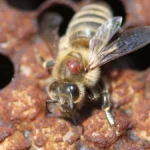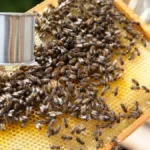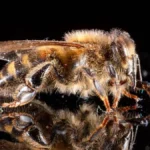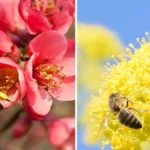Oxalic acid is becoming more and more widely used as a treatment for varroa mites. Many people wonder about oxalic acid and honey supers. What are the impacts on honey, and how do we keep things safe? Read on to find out the tricks.
What Is Oxalic Acid?
Oxalic acid is an organic acid that is naturally found in many places in nature. It gives a tart acidic taste to the stems of wood sorel plants (Oxalis species). It is toxic in higher doses and can cause skin irritation. It forms quite spiky crystals when it reacts with certain other chemicals such as calcium and these can also cause damage to tissues.
In short, Oxalic acid is “natural” but that does not mean it is nice. If you vaporize it and inhale it, it will kill you. There is a common misconception that “natural” is safe. Snake bites are natural. They are not safe. Neither is oxalic acid – we need to understand how to work with it safely.
Oxalic Acid For Varroa Control
The control of varroa mites is important in areas where the bees are of European honeybee lineages. These bees have varying degrees of susceptibility to varroa mite and it is important to monitor and control this mite.
Varroa mites employ a sneaky life strategy where the mites sneak into the brood just before it is capped. Here, the defenseless bee is planning to peacefully undergo its pupation into an adult bee. The varroa mite however bites holes in it and sucks its hemolymph. The bee is now heavily parasitized and will not emerge in a healthy state. The mites on the other hand multiply rapidly in the brood cell and emerge to go out and parasitize more brood. The growth follows an explosive trajectory, and, if it is not controlled in some way, will cause the beehive to fail.
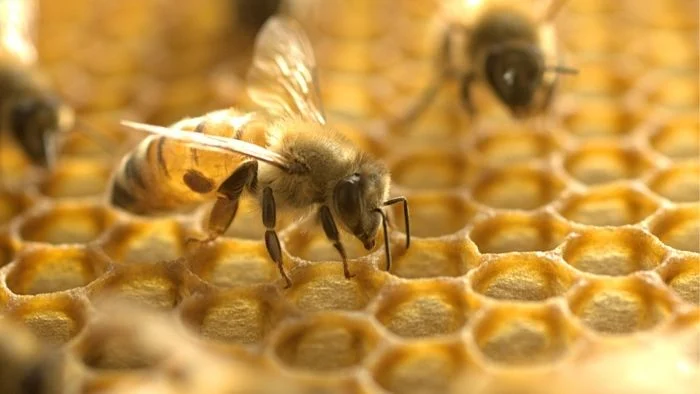
Learn more about: When Should I Treat My Bees For Mites?
Oxalic acid is one such method of control. It kills mites that are in their phoretic stage – this is the stage when mites are outside the brood and hitchhiking around the hive on the backs of bees. What this means is that the best time to use oxalic acid as a treatment is when there is very little brood! If you do have to use it when there is more brood, then you have to use it multiple times, and the risk to the hive, and also to your honey does increase.
The Two Main Methods Of Oxalic Acid Application
Vaporization
In this method, we use a vaporizer to introduce oxalic acid fumes into the hive. For dosing large numbers of hives this appears to be the more effective method. Here is an example of a simple oxalic acid vaporizer.

The Dribble Method
In this method, a solution of oxalic acid, with a bit of sugar is dribbled between the brood frames at a standard dose per frame covered. Technically, the bees are not supposed to be damaged too much by this, but I have seen some evidence to the contrary.
Oxalic Acid and Honey Supers
Oxalic acid is classified as a treatment for varroa mites, and as such, it is controlled and regulated by various laws. Because Oxalic acid is a toxic chemical these controls are quite rigorous and well thought out. Here is a link to the EPA material safety data sheet for Oxalic acid for varroa treatment.
Gloves such as these are quite useful. You must remember when working with bees that you are handling dangerous chemicals around animals with equipment that can puncture holes in protective gloves. In this regard, I have always found that bees seem to have more difficulty getting through nitrile chemical gloves than other compounds. I know that the regulations suggest a number of different glove types that are compliant – but in this regard, I would suggest the nitrile being the best.
Removing Supers Before Treatment
It is imperative that honey supers be removed from the hive before treatment and that these remain off the hives for at least two weeks prior to being replaced. This is to allow the bees to achieve maximum exposure to the medication and to prevent contamination of the honey with oxalic acid.
Given that the dribble method actually involves providing the bees with a sugar solution containing oxalic acid, there is a very real likelihood that if they have storage space, that some of this could end up in the honey supers. This is undesirable given both the toxicity and flavor impact of oxalic acid on honey.
Why Do We Always Want To Achieve Maximum Doses Of Treatments?
When it comes to treating bees it is important to understand another aspect of oxalic acid and honey supers. We are administering a dose of a chemical to a hive in order to kill varroa mites. If we have a large space, which we would if we had honey supers, we run the risk of having a lower dose of oxalic acid in the area being treated. There comes a point when this dose may be enough to kill mites that are highly susceptible to oxalic acid, but it may leave the ones that are less susceptible.
If some mites survive treatment due to having some ability to tolerate oxalic acid, then these mites will bread and multiply, and subsequent treatments if they are also insufficient to kill all the mites will enrich further for oxalic acid-resistant mites. Within a short amount of time, these “under-treatments” can destroy the efficacy of oxalic acid. This is a pretty standard method by which many treatments have actually been rendered useless – people do not follow instructions, and the result is that the pest develops resistance to the treatment.
I hope this article has helped you understand more about oxalic acid and honey supers. This is a nasty chemical – and varroa is a nasty mite. Safe application, using common sense, personal protective gear, and removing all honey supers will prolong the amount of time we can use this treatment to help out bees. Please share if you enjoyed the article.
Read more about Varroa Mite Powdered Sugar Treatment
FAQs
What is oxalic acid, and how is it used in beekeeping?
Oxalic acid is an organic compound naturally found in many plants and vegetables. In beekeeping, it is primarily used as a treatment to control varroa mites, a parasitic threat to honeybee colonies. The two most common methods of applying oxalic acid are vaporization and the dribble method, both of which target mites that are in their phoretic stage (when they are outside of brood cells). While effective, oxalic acid must be handled with care as it can be hazardous to both bees and humans if used improperly.
Is oxalic acid safe for honey bees?
Oxalic acid, when applied in the correct doses, can effectively control varroa mites without causing significant harm to honey bees. However, misuse, such as over-application or poor timing, can stress the colony or damage the bees. Additionally, oxalic acid treatments should be applied when there is little to no brood to ensure effectiveness and minimize risks to the bees.
Also read: How to Pasteurize Honey at Home: A Simple Guide
Can I use oxalic acid treatments while honey supers are on the hive?
No, it is not recommended to use oxalic acid while honey supers are on the hive. The chemical can contaminate the honey, rendering it unsafe for human consumption due to its toxicity. For this reason, supers should be removed prior to treatment to avoid contamination.
How long should I wait to replace honey supers after an oxalic acid treatment?
Honey supers should be left off the hive for at least two weeks after an oxalic acid treatment. This waiting period allows the chemical to dissipate and reduces the risk of contamination. Once the treatment is complete and the waiting period has passed, honey supers can safely be reinstalled.
What are the risks of leaving honey supers on during oxalic acid treatment?
If honey supers are left on the hive during treatment, there is a high risk of contamination, as oxalic acid can end up in the honey. Contaminated honey can have a toxic effect and alter the flavor, making it unsuitable for human consumption. Additionally, bees may store oxalic acid-laden sugar solution in the supers, further increasing the contamination risk.
What is the dribble method of applying oxalic acid, and is it safe for honey supers?
The dribble method involves applying a sugar-water solution containing oxalic acid directly onto the bees between the brood frames. While this method is effective at targeting mites, it is not safe for use when honey supers are present, as there is a risk that the bees will store the oxalic acid solution in the supers, contaminating the honey.
Why is oxalic acid treatment more effective when there is little brood?
Oxalic acid targets varroa mites when they are in their phoretic stage, which occurs when they are outside of the brood cells and riding on adult bees. When there is less brood in the hive, more mites are exposed to the treatment. Conversely, if there is a large amount of brood, many mites remain protected inside the cells, reducing the effectiveness of the treatment.
What type of personal protective equipment (PPE) is recommended when using oxalic acid?
When using oxalic acid, it is essential to wear appropriate personal protective equipment (PPE). This includes nitrile gloves, which provide better puncture resistance than other glove types, and a mask to prevent inhalation of the oxalic acid fumes, which are highly toxic. Additionally, wearing long sleeves and eye protection can prevent accidental skin and eye contact.
Can oxalic acid treatments cause varroa mites to develop resistance?
Yes, if oxalic acid is used incorrectly, such as with insufficient dosing, varroa mites may develop resistance. Incomplete treatments can allow some mites with greater tolerance to survive, reproduce, and pass on their resistant traits to future generations. This resistance can render oxalic acid treatments ineffective over time, highlighting the importance of following proper dosing guidelines.
What are the alternatives to oxalic acid for controlling varroa mites?
Alternatives to oxalic acid include other chemical treatments like formic acid, thymol-based products, and mechanical methods like screened bottom boards. Integrated pest management (IPM) strategies that combine chemical and non-chemical methods can also be effective at controlling mite populations without the risk of resistance developing. The choice of method depends on the level of infestation and the beekeeper’s treatment preferences.

Dr. Garth A. Cambray is a Canadian/South African entrepreneur and beekeeper with 28 years of experience in apiculture and specializes in adding value to honey. His Ph.D. research developed a new advanced continuous fermentation method for making mead that has resulted in a number of companies globally being able to access markets for mead. His company, Makana Meadery, exports honey mead to the USA where it is available to discerning connoisseurs. He has also developed technologies to commercially manufacture organic honey vinegar in Zambia for export globally. He holds a few patents globally in the ethanol industry and believes in technology and knowledge transfer for human development and environmental sustainability. One of his proudest achievements is the fact that the wind farm he started at one of his old apiary sites has essentially made his hometown carbon neutral.

